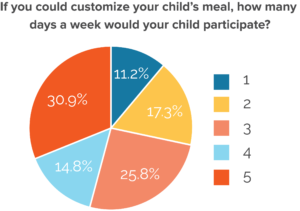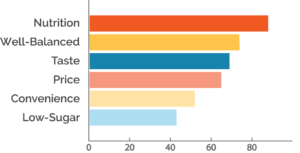Modern students and their parents aren’t satisfied with traditional lunchroom structures. Your tech-savvy students seek interactive and customizable experiences, and their parents want instant access to nutritional information along with healthier meal options.
More students than ever are packing a lunch or purchasing food off campus, leading to a dip in sales in the lunchroom. So, how can schools increase the profits for their meal program while enticing students and their parents to participate? The answer is online ordering.
Keeping up with the iGeneration
Considered digital natives, Generation Z has lived in a world with digital technology and the internet from birth; their constant access to information creates an expectation for instant gratification.
This expectation for immediate results means Gen Z students don’t want to wait in the serving line. In addition, these students reject menus that don’t offer options or customization. Online ordering allows these students to:
- Customize meals to their dietary needs and personal preferences from a smartphone or computer.
- Bypass the lunch line and pick up their order upon entering the lunchroom.
These key benefits keep your students happy all while cutting down lunchroom traffic without slashing sales.
Online Ordering and the Millennial Parent
Millennial parents value nutrition more than the generations that came before, and like their Gen Z children, Millennials expect to have access to instant information. It is so easy for people to access menus, ingredients and nutrition facts online, so they expect the same from schools.
Online ordering does just that. Parents can choose which meals their child receives while having access to menus, interactive nutritionals and potential allergens.
There’s also a baked-in learning opportunity: while guiding their child through the online ordering process, parents can teach their children how to select healthy meal options at school.
The chart above shows the factors that Millennial parents consider when purchasing meals for their children. It’s plain to see that nutrition is at the top.
Advanced Orders Increase Healthy Choices
A study conducted by the University of Pennsylvania and Carnegie Mellon University found that adults and college students are likelier to make spontaneous and unhealthy lunch selections when already hungry.
“Our results show that ordering meals when you’re already hungry and ready to eat leads to an overall increase in the number of calories ordered and suggest that by ordering meals in advance, the likelihood of making indulgent purchases is drastically reduced,” said lead author Eric M. VanEpps, a postdoctoral researcher at the University of Pennsylvania’s Perelman School of Medicine.
This same concept applies to K‑12 students. Online ordering school meals increases the likelihood that children make healthier options since they aren’t ordering when they are already hungry.
Online Ordering Improves Food Safety
Did you know that around 20% of students with food allergies will have a reaction while at school? Online ordering can help prevent students from accidentally coming into contact with allergens.
Parents and students have a clear understanding of the ingredients and potential allergens for meal options when online ordering is available. This makes meal customization far easier and is ideal for the junk-food-loving students in lower elementary.
Online ordering also offers your staff more time to prepare a safe and allergen-free meal.
Online Ordering Increases Participation
While online ordering is new to the world of school nutrition, there is proof that its popularity is on the rise.
In a parent poll conducted by Douglas County School District, 60% of parents indicated that they would be likely or very likely to use an online ordering system for their child’s lunch.

These parents also said they would take part in the lunch program five days a week if they could customize their student’s meal.
In another district, elementary school participation dropped by 15% because students claimed they packed a lunch on the days the menu items were not appealing.
After implementing a “grab-and-go” lunch, the district saw a participation increase of 15% in the first week and 20% by the end of the second week.
Though many schools have yet to add it, the response so far has shown that online ordering is the way of the future.
Successfully Implementing Online Ordering in your Lunchroom
Cafeteria management systems make it easier than ever before to integrate pre-ordering into your cafeteria’s operations. Here are the best practices for adding online orders to your school lunch program.
- Add menu items eligible for online ordering during online ordering setup.
- Don’t forget to include nutritional information and options to accommodate dietary restrictions and preferences.
- Ensure that students, parents and faculty can easily order and customize meals using a computer or mobile device.
- When an order come into the system, print a label that includes the student’s name, number and custom order. Then, adhere the label to the meal for easy pick up.
- Station your pick-up location out of the way of the regular lunch line. You can assign a staff member to manage the station and ensure students pick up the correct order.
- Set up a balance limit and cut-off time for orders. This ensures your staff can fill orders before lunch time.
Monitor and track the efficiency of your cut-off time for a couple of weeks after implementation. You can always make adjustments as online ordering popularity increases.
Online Ordering is Where It’s At
If you want to appeal to modern generations, you need to offer modern conveniences. A fantastic way to increase participation in a school meal program is to offer online school meal ordering.
Implementing online pre-ordering thrills your customization-happy students, your health-focused parents relieved, and your lunch operations more successful than ever before.
Free eBook: A Guide to the New Normal in K‑12 Food Service
School food service has changed drastically. This free guide is loaded with information on running your program in a contactless world.

